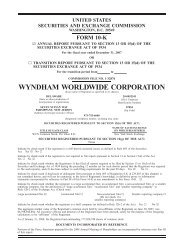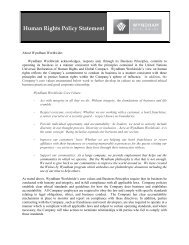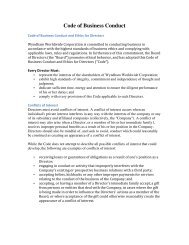WYNDHAM WORLDWIDE CORPORATION
WYNDHAM WORLDWIDE CORPORATION
WYNDHAM WORLDWIDE CORPORATION
Create successful ePaper yourself
Turn your PDF publications into a flip-book with our unique Google optimized e-Paper software.
cash flow model in determining the fair values of vacation ownership contract receivables. The primary assumptions<br />
used in determining fair value are prepayment speeds, estimated loss rates and discount rates. We use a durationbased<br />
model in determining the impact of interest rate shifts on our debt and interest rate derivatives. The primary<br />
assumption used in these models is that a 10% increase or decrease in the benchmark interest rate produces a<br />
parallel shift in the yield curve across all maturities.<br />
We use a current market pricing model to assess the changes in the value of our foreign currency derivatives<br />
used by us to hedge underlying exposure that primarily consist of the non-functional current assets and liabilities of<br />
us and our subsidiaries. The primary assumption used in these models is a hypothetical 10% weakening or<br />
strengthening of the U.S. dollar against all our currency exposures as of December 31, 2010. The gains and losses<br />
on the hedging instruments are largely offset by the gains and losses on the underlying assets, liabilities or expected<br />
cash flows. As of December 31, 2010, the absolute notional amount of our outstanding foreign exchange hedging<br />
instruments was $480 million. A hypothetical 10% change in the foreign currency exchange rates would result in an<br />
immaterial change in the fair value of the hedging instrument as of December 31, 2010. Such a change would be<br />
largely offset by an opposite effect on the underlying assets, liabilities and expected cash flows.<br />
Our total market risk is influenced by a wide variety of factors including the volatility present within the<br />
markets and the liquidity of the markets. There are certain limitations inherent in the sensitivity analyses presented.<br />
While probably the most meaningful analysis, these “shock tests” are constrained by several factors, including the<br />
necessity to conduct the analysis based on a single point in time and the inability to include the complex market<br />
reactions that normally would arise from the market shifts modeled.<br />
We used December 31, 2010 market rates on outstanding financial instruments to perform the sensitivity<br />
analysis separately for each of our market risk exposures — interest and foreign currency rate instruments. The<br />
estimates are based on the market risk sensitive portfolios described in the preceding paragraphs and assume<br />
instantaneous, parallel shifts in interest rate yield curves and exchange rates.<br />
ITEM 8. FINANCIAL STATEMENTS AND SUPPLEMENTARY DATA<br />
See Financial Statements and Financial Statement Index commencing on page F-1 hereof.<br />
ITEM 9. CHANGE IN AND DISAGREEMENTS WITH ACCOUNTANTS ON ACCOUNTING AND<br />
FINANCIAL DISCLOSURE<br />
None.<br />
ITEM 9A. CONTROLS AND PROCEDURES<br />
(a) Disclosure Controls and Procedures. Our management, with the participation of our Chairman and Chief<br />
Executive Officer and Chief Financial Officer, has evaluated the effectiveness of our disclosure controls<br />
and procedures (as such term is defined in Rules 13a-15(e) under the Securities Exchange Act of 1934,<br />
as amended (the “Exchange Act”)) as of the end of the period covered by this report. Based on such<br />
evaluation, our Chairman and Chief Executive Officer and Chief Financial Officer have concluded that,<br />
as of the end of such period, our disclosure controls and procedures are effective.<br />
(b) Management’s Report on Internal Control over Financial Reporting. Our management is responsible for<br />
establishing and maintaining adequate internal control over financial reporting, as defined in<br />
Rule 13a-15(f) under the Exchange Act. Our management assessed the effectiveness of our internal<br />
control over financial reporting as of December 31, 2010. In making this assessment, management used<br />
the criteria set forth by the Committee of Sponsoring Organizations of the Treadway Commission<br />
(COSO) in Internal Control — Integrated Framework. Based on this assessment, our management<br />
believes that, as of December 31, 2010, our internal control over financial reporting is effective. Our<br />
independent registered public accounting firm has issued an attestation report on the effectiveness of our<br />
internal control over financial reporting, which is included within their audit opinion on page F-2.<br />
ITEM 9B. OTHER INFORMATION<br />
None.<br />
73







